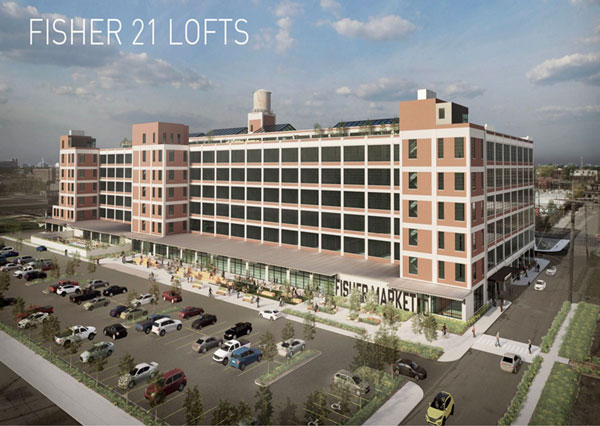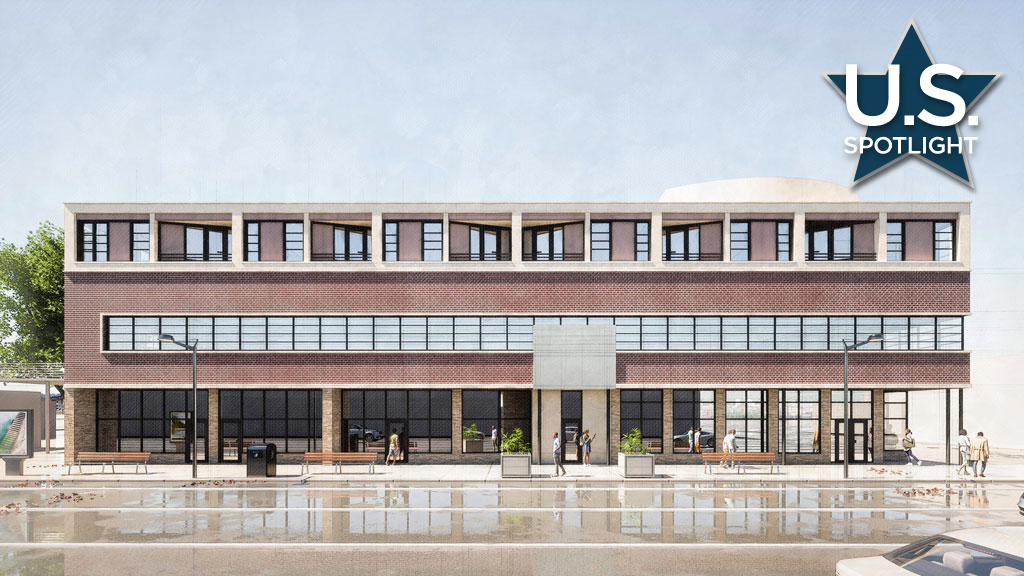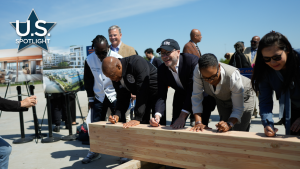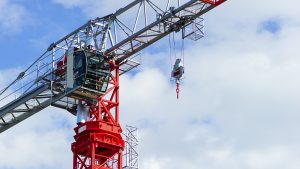One of Detroit’s major industrial ruins, the infamous Fisher Body Plant 21, built 1919 and lying dormant since 1993, will be resurrected as a mixed use residential and commercial complex on the city’s near east side.
The major eyesore, which sits at the juncture of perhaps the city’s busiest freeway interchange where I-75 and I-94 meet, is also the largest city redevelopment project led by a team of African American businessmen under Kappa Construction Corp.
The 600,000-square-foot, six-storey plant on almost five acres is being rebuilt at a cost of $145 million. On tap are 435 rental apartments, 38,000 square feet of commercial space, outdoor and indoor amenities, including a surface market and food hall, café, second-floor co-working area and internal atrium and courtyard.
The rebuild, to be known as Fisher 21 Lofts, comes at a time when nearby growth is also happening, such as an extension of Hastings Street, which used to be a vibrant African American business district. It was usurped by the building of Interstate 375 in the 1960s, but plans are to demolish the one-mile spur as well as reconfigure the I-75/I-94 interchange, already drawing much small enterprise commercial interest.
The redevelopment is the brainchild of seasoned Detroit developers Greg Jackson and Richard Hosey.
“I always wondered what it could become,” Jackson said.
He ran into Hosey one day and the building came up in conversation and they both had the same idea – remake the site.
“My eyes lit up, his eyes lit up. Wow, you too?” Jackson said.
They kicked the tires and found the ruin structurally sound. Moreover, a federal environmental assessment had been completed on the site, which at that point was owned by the City of Detroit.

But, given Detroit’s notorious widespread urban blight and despite a partial downtown recovery since the 1990s, it was still more than difficult to raise financing.
“We knocked on, I think, 15 bank doors, several people rebuffed us,” Jackson said.
There is an additional “eight or nine different layers” of financing, including community redevelopment program dollars, historic tax credits, tax increment financing and brownfield credits. And the developers put in $15 million of their own money.
“There’s no other (city) development that any developer has put as much equity dollars,” Jackson said.
Detroit Mayor Mike Duggan was originally “unconvinced” that the hulk could be saved, Jackson said. But the dual’s redevelopment track record plus the fact “we were putting substantial dollars” changed the city’s tune to the extent it received almost $5 million in “crucial gap financing” through the Michigan Economic Development Corporation.
Construction is slated over the next two years.
Though generally structurally sound, part of the building will have to be torn down and the rest shored up to concrete.
“Even though the structure was built to last a thousand years there was some water infiltration into the property, and we had to make sure that we corrected,” said Jackson.
The developers are committed to having the project be built by Black, Hispanic and female contractors.
“We think that sets our development apart from so many others because we want these people to be first tier contractors not just subcontractors,” he said.
Meanwhile, on the far east side of the city, one of the first Arthur Murray dance studios in the city where the brand had its first franchise, a two-storey mid-century modern classic, is being rebuilt with the working title The Arthur Murray.
“It still has the Arthur Murray logo on the dance floor,” developer Emery Matthews of Real Estate Interests LLC said. The rectangular flat roof structure conforms to the International Style. Like many other once thriving commercial buildings in the Motor City, it was abandoned and left vacant, Matthews said.
“What we’ve tried to do is harken back to those motifs and principles to recreate a building that’s authentically Detroit but also reflects the character and history of the original design,” he said.
The building is located on a similarly once thriving business strip, East Warren Avenue, but in an area where there remains some residential and commercial stability. Moreover, a city strategic plan has focused “a lot of resources on the neighborhood in general,” Matthews said.
“So, we wouldn’t be an island, we’d be part of a broader redevelopment plan.”
Second, it’s an opportunity to create “a type of housing that we haven’t seen a whole lot in Detroit, that being revived commercial corridor housing,” he said.
The construction plan is to add a third floor with the top two floors comprising 32 residential apartments with 8000 square feet of ground floor retail, as per the original building. Rental pricing will “reflect” the neighborhood.
But like the Fisher 21 Lofts, a major stumbling block was financing.“A building like this is not feasible without a tremendous amount of support from both the community and the city and the state both economically as well as with development regulations,” Matthews said, adding the project “probably wouldn’t happen if we didn’t already have deep ties to the community and to the city.”
Design will be completed this spring and construction underway “shortly thereafter,” he added.
The Arthur Murray will receive $2.1 million in gap funding.
The two projects were perhaps the more notable among five the City of Detroit announced for grant funding in January – $14.5 million towards $255 million of investment in mixed-use buildings including 551 residential units in “strategic areas” of the city, most led by African American developers.










Recent Comments